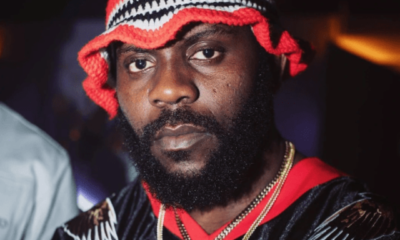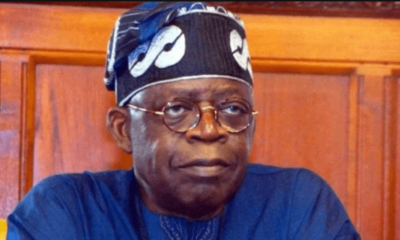Tech
Apple IPhone 12 Series Officially Unveiled
Apple has entered the 5G era – all four new models feature both the sub-6 flavor of 5G as well as mmWave. The latter doubles the peak download speeds (up to 4.0 Gbps), but those are limited to Verizon in the US for now.
This year the Pro models come in two sizes, 6.1” on the iPhone 12 Pro and 6.7” on the iPhone 12 Pro Max. That is up from 5.8” and 6.5” on the 11-series, Apple has embraced the large screen (while simultaneously going smaller than anyone else with the iPhone 12 mini). Slimmer bezels keep the new models from getting too huge.
As before, both models have OLED displays. And as before, they run at 60Hz – the high refresh rate update will have to wait for next year. Also, the notch lives on, Apple’s commitment to Face ID has not wavered in the wake of in-display fingerprint readers.
The new displays have slightly higher resolution than their predecessors – on the Pro that is 1,170 x 2,532 px, the Pro Max is up to 1,284 x 2,778 px. The peak brightness remains at the impressive 1,200 nits.
To keep the display safe, Apple once again partnered with Corning to create the Ceramic Shield material. This has 4x the drop resistance of previous the glass.
The company also updated the design language of its phones, bringing it closer to the iPad Pros. This means that the sides are squared off, echoing the glory days for the iPhone 4. As before, the chassis is made from stainless steel. Pacific Blue is the new hero color alongside classics such as Gold, Gray and Silver.
The new generation has best-in-class water resistance, being able to dive down to 6 meters underwater for an hour. The 2019 generation could only go down to 4 meters.
The two Pro models are not equal when it comes to the camera. The larger iPhone 12 Pro Max starts off with a larger 1/1.7” sensor (1.7 µm pixels) that is 47% larger than the 12 Pro and the older 11 Pro Max. Combined with the f/1.6 aperture, this allows 87% more light to reach the sensor. Also, Apple changed the image stabilization to use sensor shift instead of moving the optics lens to counteract movements. This allows it to react faster, making 5,000 adjustments per second.
The Pro Max also features a longer focal length on its zoom camera, allowing for 2.5x magnification. The OIS on this cam sticks with the usual lens-based approach.
The iPhone 12 Pro gets the brighter lens, f/1.6, but keeps the old sensor with lens rather than sensor stabilization. That sensor still gets 27% more light. The vanilla Pro also gets the old telephoto camera, with an f/2.0 lens with 52 mm focal length (meaning 2x magnification over the main cam) and, again, classic OIS.
Now all cameras support Night mode, including the selfie camera and ultra wide (the 11 Pro only had it on the main cam). This is in part thanks to the new chipset does have more number-crunching power, but we’ll get to that.
The ultra wide cam is unchanged with an f/2.4 lens with 120° field of view (13 mm focal length).
This year the iPhone Pros adopt the LiDAR system of the iPad Pros. This enables Night mode portraits. This also reduces the time to get an autofocus lock in the dark by the impressive 6 times.
The iPhone 12 Pro are the only phones on the market to record Dolby Vision video. The faster chipset color-grades every frame of 10-bit video for best quality. The new ProRAW feature records all the data you expect from a RAW format while also saving the image processing decisions that the phone made on the spot, making quick touch ups faster as you have a solid base to work from.
The new iPhones are smart about how they use their new 5G connectivity. When they don’t need the extra speed, the Smart Data mode switches to 4G automatically to preserve battery.
The big innovation in battery charging is an old one – the MagSafe that you loved on MacBooks is back. This time it’s used for wireless charging and it delivers 15W of power (up from 7.5W for regular Qi charge). Also, this uses magnets to grab onto a snap-on wireless charging. This also enables MagSafe accessories, which uses the magnetic holding power to keep them semi-permanently attached.
Wired charging got faster too, the new models support up to 20W. However, you’ll have to buy the charger separately as Apple removed the in-box charger and the headset. You only get a USB-C to Lightning cable that (finally!) lets you connect the iPhone to your MacBook. Apple presented this as a move to reduce carbon emissions, a step on its path to become carbon neutral by 2030.
Apple A14 Bionic is at the heard of the iPhone 12 Pro duo – the first 5nm chipset in the world, featuring a whopping 11.8 billion transistors, 40% more than the A13. It features 2 big CPU cores and 4 small cores, which together deliver a 50% higher performance than its predecessor. Similarly, the 4-core GPU is good for a 50% increase over last year’s iPhone. Machine learning has seen a 70% increase in performance as well to handle the ever-growing applications of AI.
Besides the zoom cam, another reason to buy into the Pro models is more storage. Apple doubled the base storage to 128GB, with 256GB and 512GB upgrade options.
The iPhone 12 Pro starts at $1,000 and will be up on pre-order this Friday and available next week. The iPhone 12 Pro Max will start at $1,100 and will be available to book on November 6 with sales starting a week later – November 13.
iPhone 12 and 12 mini
Apple opened its iPhone announcements for 2020 with the iPhone 12 and iPhone 12 mini, bringing the more affordable line some of the premium features usually reserved for the Pro line.
Apple iPhone 12
The iPhone 12, it replaces its predecessor’s IPS LCD with a Super XDR OLED display of the same 6.1-inch diagonal and a much higher 2532x1170px resolution (460 pixels per inch). Apple advertises 1200 nits of peak brightness, matching the Pro models.
The screen has a standard refresh rate of 60Hz and the same old notch. What has improved is the glass covering the display. Apple calls it Ceramic Shield and it was co-developed with Gorilla Glass maker Corning.
Apple says that Ceramic Shield glass is “4 times better drop performance” and is “tougher than any smartphone glass”.
5G was a huge part of Apple’s presentation. The iPhone 12 supports mmWave in the US as well as the more widely spread (but slower) sub-6GHz 5G. Apple has tested speeds across 100 carriers and says it can achieve 3.5Gbps in controlled environments and up to 4Gbps in ideal conditions.
Apple went with a more refined and thinner design for the iPhone 12. The phone is 11% thinner, 16% lighter and 15% smaller in volume than the iPhone 11.
Like the iPhone 11, the iPhone 12 comes in a variety of colors – a new Blue, Green, Product Red, White and Black.
As expected Apple’s A14 Bionic powers the iPhone 12. It has a six-core (two powerful and four efficient cores) CPU and quad-core GPU and brings the total transistors to 11.8 billion, or about 40% more than the A13 Bionic, powering last year’s iPhones. Apple claims the A14 Bionic is 50% faster in both CPU and GPU than any other smartphone chipset.
The A14 Bionic can deliver 80% faster machine learning than the A13 Bionic with a reported support for 11 trillion operations per second – which would enable faster performance from Face unlock to camera operation.
The Apple iPhone 12 gains a new wide camera with a brighter f/1.6 aperture, promising up to 27% better light capture and an additional ultrawide shooter. Both inherit Apple’s new Smart HDR 3 with improved white balance, texture and saturation.
Both rear cameras as well as the selfie camera are now capable of shooting Night Mode images.
As expected Apple has removed the Earpods and charger from the iPhone retail package, which has enabled a tiny retail box and a much-improved carbon footprint. What’s new this year is the return of MagSafe (yes, the name of the old MacBook charging connector), which enables Apple’s special new wireless charger to snap onto the rear of the iPhone 12 and deliver up to 15W wireless charging. Regular Qi wireless chargers go up to 7.5W, while wired charging maxes out at 20W if you purchase the required adapter.
Pre-orders for the iPhone 12 will open on October 16 with shipments beginning on October 23, starting at $799.
Apple iPhone 12 mini
Apple also unveiled what may very well prove to be the star of the show – the iPhone 12 mini. Owning up to its diminutive name, the iPhone 12 mini is smaller than the 4.7-inch iPhone SE (2020), while featuring a larger 5.4-inch 2340x1080px Super XDR OLED screen with 476 ppi and the same up to 1200 nits of brightness as the rest of the lineup.
The iPhone 12 mini shares the display technology, the chipset, the camera system, wireless charging, IP68 rating and color options as the bigger iPhone 12.
Apple will offer the iPhone 12 and 12 mini in 64GB, 128GB and 256GB storage options in Blue, Green, Black, White and Product Red colors. The iPhone 12 mini will begin selling on November 6 and will ship on November 13.
-

 Celebrity Gossip & Gist2 days ago
Celebrity Gossip & Gist2 days ago“The money wey dem pay me don expire” – Moment Burna Boy stops his performance at the Oando PLC end of the year party (Video)
-

 Economy2 days ago
Economy2 days agoGoods worth millions of naira destroyed as fire guts spare parts market in Ibadan
-

 Celebrity Gossip & Gist14 hours ago
Celebrity Gossip & Gist14 hours agoMoment stage collapses on Odumodublvck during concert performance (Video)
-

 Economy13 hours ago
Economy13 hours agoPresident Tinubu cancels Lagos engagements in honor of food stampede victims








